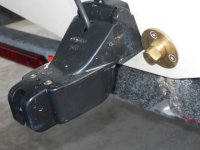The reason I don't put the transducer at the lowest part of the hull, is that incase of grounding---for example stern to beach at Lake Powell, would be a potential semi intentional grounding--there would be more likely damage to the transducer, although in most cases it will flip up. If it does flip up, it is harder to put down, on the Tom Cat, because of the outboard bracket.
My feeling is that the water is a little less disturbed on the outer part (again I use the common term "outboard" of the drain plug.
I drilled two holes thru the Starboard for screws to attach it to the hull's transom.
I counter sunk the heads, so that you can mount the transducer screws at any place.
Put the block of Starboard, about 1/8" above the bottom of the hull and parallel to it. Drill two pilot holes into the transom, thru the Starboard block. Then over drill, these holes, fill with thickened epoxy, and then drill pilot holes for the screws to hold the Starboard in place. This way, there is no way for water intrusion into the transom.
There are very few materials which will stick to Starboard reliably. Various methods have been used to seal the Starboard to the transom: I cut groves into the starboard (best with a small dovetail bit in a Dremel tool, but cutting about 1/8" cuts with a saw are also adequate. You also want the back (hull) surface of the Starboard to be rough. (I use a rasp). Then apply either 5200, or G Flex epoxy to the hull side of the Starboard, and then secure the Starboard to the transom with SS or bronze Screws. I put a dab of the 5200 or G Flex onto the point of the screw (after it its thru the Starboard) before putting into the pilot hole,.
There are those who don't over drill and put epoxy plugs in, and those who don't grove the back of the Starboard. But the technique I outlined is least likely to allow any water intrusion into the transom. (The Transom of the Tom Cat 255 is foam--but you still don't want water in it.)


